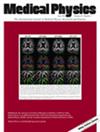Design and characterization of a novel scintillator array for UHDR PBS proton therapy surface dosimetry
Abstract
Background
Ultrahigh dose rate (UHDR) proton therapy has shown promise in normal tissue sparing by enhancing the therapeutic ratio through a method termed the FLASH effect. As in all radiotherapy, accurate in vivo dosimetry is crucial for quality assurance of safe and efficient treatment delivery. However, this remains a challenge for UHDR as existing dosimetry systems lack the spatial and temporal resolution required to verify dose and dose rate in complex anatomical regions, especially for pencil beam scanning (PBS) proton therapy.
Purpose
This study aims to develop and evaluate a novel 3D surface dosimetry method for UHDR PBS proton therapy using high-speed imaging of a scintillator array, coupled with stereovision to provide real-time, high-resolution surface dose monitoring during treatment. The spatial, temporal, and dosimetric components of the proposed system are validated via imaging of a custom QA phantom and are compared against a gafchromic film reading of the same field delivered onto a flat surface.
Methods
A freely deformable multielement scintillator array was designed with a single element pitch of 7.5 mm and interelement gap of 0.5 mm. Scintillation linearity with dose was evaluated along with the variation in scintillator response with increasing imaging and irradiation angles. Water-equivalent thickness (WET) testing was conducted to evaluate beam attenuation at two energy levels. Scintillation emission in response to dose delivery was imaged at 1000 Hz using a high frame rate camera (BeamSite Ultra, DoseOptics LLC) and the array position was monitored via a 2-camera stereovision system. Imaging system setup was validated using a custom 3D QA phantom to assess spatial accuracy and guide systematic setup correction. Stereovision properties of each array element were used to guide angular emission correction, and geometric transformation to beams-eye-view (BEV). Kernel-based residual spot fitting was applied to derive cumulative dose maps which were then compared to the flat film dose profile of a 5 × 5 cm UHDR PBS delivery using 3%/2 mm gamma analysis. PBS and maximum dose rate maps were also calculated.
Results
System setup achieved an average localization error of 0.62 mm, surpassing the typical 1+ mm threshold used in clinical practice. Intensity correction based on angular information was applied and yielded a cumulative spot dose uncertainty of ∼1% (5.428 mGy). The processed dose map was compared to film via gamma analysis with 3%/2 mm criteria and showed a 99.9% passing rate, indicating high agreement between the planned and measured dose profiles. The WET of the scintillator array was measured to be 1.1 mm, minimizing its impact on dose distribution.
Conclusion
The novel scintillator array system provides accurate, real-time surface dose monitoring with high spatial and temporal resolution, making it a promising tool for in vivo dosimetry in UHDR proton therapy. Future work will focus on optimizing the system and expanding its application to other modalities, such as photon and electron therapy.

 求助内容:
求助内容: 应助结果提醒方式:
应助结果提醒方式:


